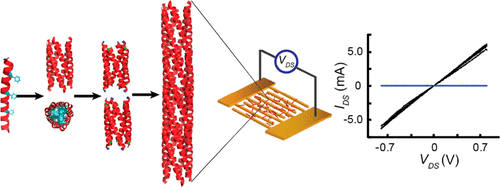Our official English website, www.x-mol.net, welcomes your feedback! (Note: you will need to create a separate account there.)
Electronic Conductivity in Biomimetic α-Helical Peptide Nanofibers and Gels
ACS Nano ( IF 17.1 ) Pub Date : 2018-03-14 00:00:00 , DOI: 10.1021/acsnano.7b08756 Nicole L. Ing 1 , Ryan K. Spencer 1 , Son H. Luong 1 , Hung D. Nguyen 1 , Allon I. Hochbaum 1, 2
ACS Nano ( IF 17.1 ) Pub Date : 2018-03-14 00:00:00 , DOI: 10.1021/acsnano.7b08756 Nicole L. Ing 1 , Ryan K. Spencer 1 , Son H. Luong 1 , Hung D. Nguyen 1 , Allon I. Hochbaum 1, 2
Affiliation

|
Examples of long-range electronic conductivity are rare in biological systems. The observation of micrometer-scale electronic transport through protein wires produced by bacteria is therefore notable, providing an opportunity to study fundamental aspects of conduction through protein-based materials and natural inspiration for bioelectronics materials. Borrowing sequence and structural motifs from these conductive protein fibers, we designed self-assembling peptides that form electronically conductive nanofibers under aqueous conditions. Conductivity in these nanofibers is distinct for two reasons: first, they support electron transport over distances orders of magnitude greater than expected for proteins, and second, the conductivity is mediated entirely by amino acids lacking extended conjugation, π-stacking, or redox centers typical of existing organic and biohybrid semiconductors. Electrochemical transport measurements show that the fibers support ohmic electronic transport and a metallic-like temperature dependence of conductance in aqueous buffer. At higher solution concentrations, the peptide monomers form hydrogels, and comparisons of the structure and electronic properties of the nanofibers and gels highlight the critical roles of α-helical secondary structure and supramolecular ordering in supporting electronic conductivity in these materials. These findings suggest a structural basis for long-range electronic conduction mechanisms in peptide and protein biomaterials.
中文翻译:

仿生α-螺旋肽纳米纤维和凝胶中的电子电导率
远程电子电导率的例子在生物系统中很少见。因此,对通过细菌产生的蛋白质丝进行的微米级电子传输的观察是值得注意的,这为研究通过基于蛋白质的材料进行传导的基本方面以及生物电子材料的自然灵感提供了机会。从这些导电蛋白纤维中借入序列和结构基序,我们设计了在水性条件下形成电子导电纳米纤维的自组装肽。这些纳米纤维的电导率之所以与众不同,有两个原因:首先,它们支持电子传递的距离比蛋白质预期的大几个数量级;其次,电导率完全由缺乏延长的共轭氨基酸,π堆积,或现有有机和生物混合半导体的氧化还原中心。电化学传输测量表明,纤维支持欧姆电子传输和水性缓冲液中电导的类金属温度依赖性。在较高的溶液浓度下,肽单体会形成水凝胶,纳米纤维和凝胶的结构和电子性能的比较突出了这些材料中α-螺旋二级结构和超分子有序在支持电子导电性方面的关键作用。这些发现为肽和蛋白质生物材料中的远程电子传导机制提供了结构基础。电化学传输测量表明,纤维支持欧姆电子传输和水性缓冲液中电导的类金属温度依赖性。在较高的溶液浓度下,肽单体会形成水凝胶,纳米纤维和凝胶的结构和电子性能的比较突出了这些材料中α-螺旋二级结构和超分子有序在支持电子导电性方面的关键作用。这些发现为肽和蛋白质生物材料中的远程电子传导机制提供了结构基础。电化学传输测量表明,纤维支持欧姆电子传输和水性缓冲液中电导的类金属温度依赖性。在较高的溶液浓度下,肽单体会形成水凝胶,纳米纤维和凝胶的结构和电子性能的比较突出了这些材料中α-螺旋二级结构和超分子有序在支持电子导电性方面的关键作用。这些发现为肽和蛋白质生物材料中的远程电子传导机制提供了结构基础。纳米纤维和凝胶的结构和电子性能的比较表明,α-螺旋二级结构和超分子有序在支持这些材料的电子导电性方面起着至关重要的作用。这些发现为肽和蛋白质生物材料中的远程电子传导机制提供了结构基础。纳米纤维和凝胶的结构和电子性能的比较表明,α-螺旋二级结构和超分子有序在支持这些材料的电子导电性方面起着至关重要的作用。这些发现为肽和蛋白质生物材料中的远程电子传导机制提供了结构基础。
更新日期:2018-03-14
中文翻译:

仿生α-螺旋肽纳米纤维和凝胶中的电子电导率
远程电子电导率的例子在生物系统中很少见。因此,对通过细菌产生的蛋白质丝进行的微米级电子传输的观察是值得注意的,这为研究通过基于蛋白质的材料进行传导的基本方面以及生物电子材料的自然灵感提供了机会。从这些导电蛋白纤维中借入序列和结构基序,我们设计了在水性条件下形成电子导电纳米纤维的自组装肽。这些纳米纤维的电导率之所以与众不同,有两个原因:首先,它们支持电子传递的距离比蛋白质预期的大几个数量级;其次,电导率完全由缺乏延长的共轭氨基酸,π堆积,或现有有机和生物混合半导体的氧化还原中心。电化学传输测量表明,纤维支持欧姆电子传输和水性缓冲液中电导的类金属温度依赖性。在较高的溶液浓度下,肽单体会形成水凝胶,纳米纤维和凝胶的结构和电子性能的比较突出了这些材料中α-螺旋二级结构和超分子有序在支持电子导电性方面的关键作用。这些发现为肽和蛋白质生物材料中的远程电子传导机制提供了结构基础。电化学传输测量表明,纤维支持欧姆电子传输和水性缓冲液中电导的类金属温度依赖性。在较高的溶液浓度下,肽单体会形成水凝胶,纳米纤维和凝胶的结构和电子性能的比较突出了这些材料中α-螺旋二级结构和超分子有序在支持电子导电性方面的关键作用。这些发现为肽和蛋白质生物材料中的远程电子传导机制提供了结构基础。电化学传输测量表明,纤维支持欧姆电子传输和水性缓冲液中电导的类金属温度依赖性。在较高的溶液浓度下,肽单体会形成水凝胶,纳米纤维和凝胶的结构和电子性能的比较突出了这些材料中α-螺旋二级结构和超分子有序在支持电子导电性方面的关键作用。这些发现为肽和蛋白质生物材料中的远程电子传导机制提供了结构基础。纳米纤维和凝胶的结构和电子性能的比较表明,α-螺旋二级结构和超分子有序在支持这些材料的电子导电性方面起着至关重要的作用。这些发现为肽和蛋白质生物材料中的远程电子传导机制提供了结构基础。纳米纤维和凝胶的结构和电子性能的比较表明,α-螺旋二级结构和超分子有序在支持这些材料的电子导电性方面起着至关重要的作用。这些发现为肽和蛋白质生物材料中的远程电子传导机制提供了结构基础。



























 京公网安备 11010802027423号
京公网安备 11010802027423号